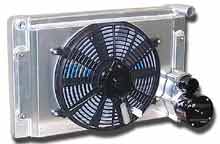I started to use a Snow White pump which is an Opel GT pump fit into an aluminum casting that takes the place of the original pump. I decided to go electric as I was fitting the engine. The plumbing from the Cleveland didn't fit the car so well. I simply made a plate to replace the pump body and welded a V shaped block on the inside to divert the water both ways into the heads. May not have needed the V block, but my labor is cheap!
Davies Craig don't recommend attaching the pump to anything solid (like the bracket/tube mine is on. According to them, tests on racing engines show vibration makes the pump seal leak. So they would rather see the pump mounted and supported by the suction and discharge hoses.
4K miles on mine with no problems so far.
I fabed an 1 1/2" pipe from the pump cover to the pump which I mounted just in front of and to the left of the oil pan. The variable speed control for the pump is located by the right side door post behind the dash (near the paper bag on the rocker panel in the photo).
There is not thermostat. The temperature sensor for the controller is mounted in a Swagelok fitting where the thermostat used to be. Warm up of the engine is within 5 minutes at 2000 rpm setting in the garage. Within 4 or 5 miles driving.
The little booster pump is only for the heater core. Fluid doesn't want to flow across the heater core when the radiator presents a less restricted flow path. The booster pump forces it through the core.
My installation is not the one Bob is refering to.
As Bob said, a TIG machine is certainly helpful!
Here's some photos of how I set mine up.










